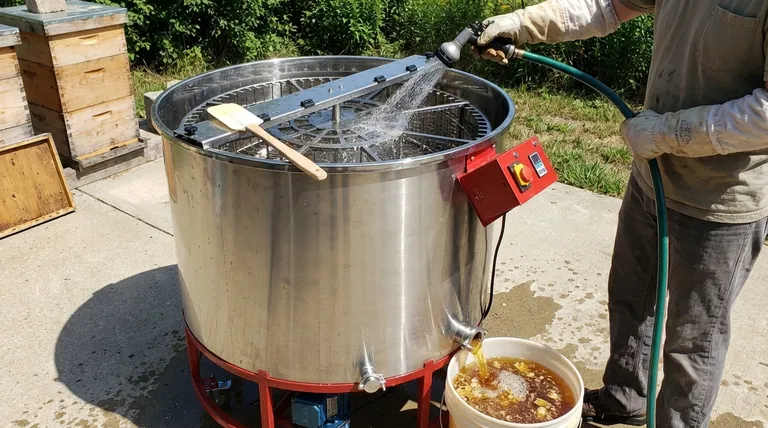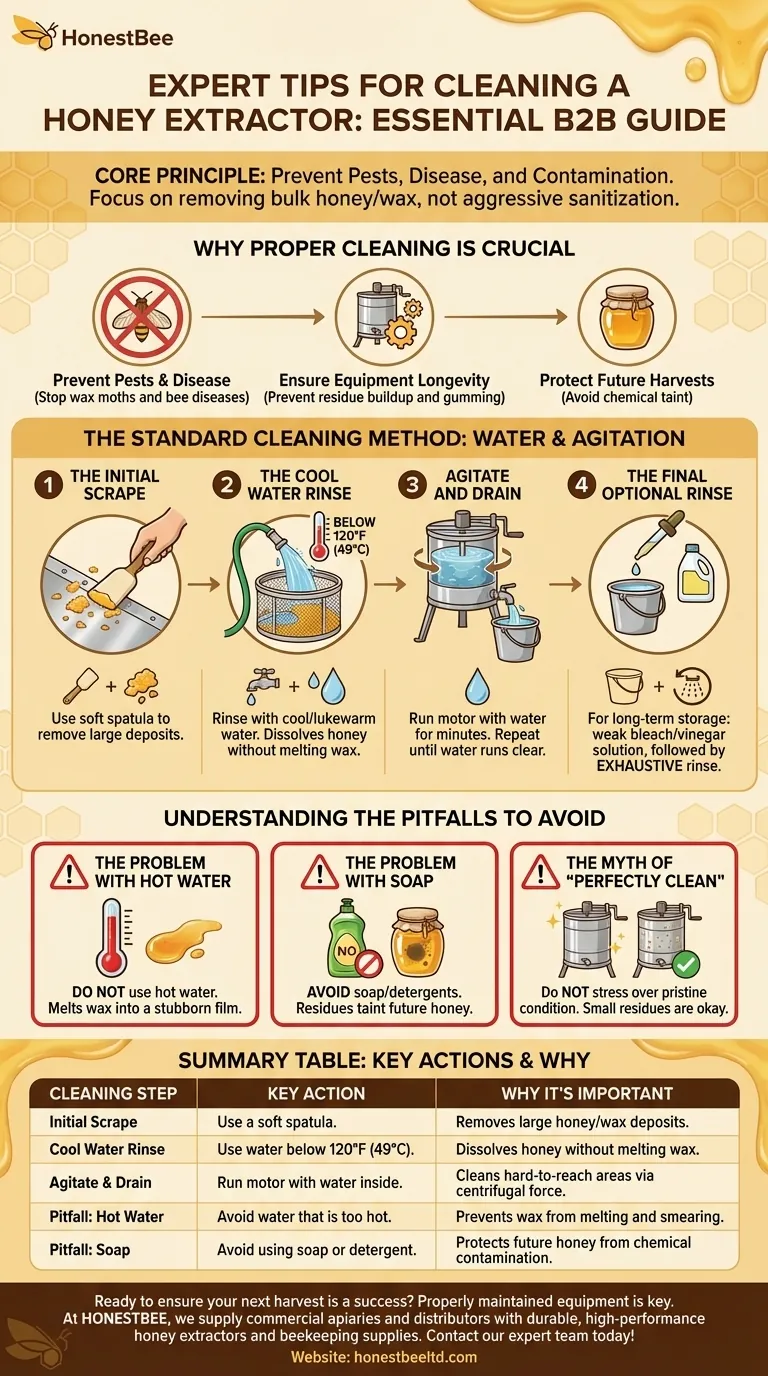The most effective way to clean a honey extractor is often counterintuitive. The best practices involve using cool or lukewarm water, avoiding soap, and accepting that the goal is not a "like-new" shine but rather the removal of bulk honey and wax residue to prepare the machine for storage.
The core principle of cleaning a honey extractor is to prevent pests and disease while protecting your equipment and future honey harvests from contamination. This means focusing on removing excess honey and wax with simple methods, rather than aggressive sanitization.

Why Proper Cleaning is Crucial
Before detailing the methods, it's important to understand the goals. Proper cleaning isn't just about appearances; it's a critical step in responsible beekeeping.
Preventing Pests and Disease
Leaving significant honey residue in an extractor is an open invitation for pests like wax moths.
More importantly, unclean equipment can harbor and spread bee diseases between your hives during the next harvest.
Ensuring Equipment Longevity
Residual honey can crystallize and harden, potentially gumming up the extractor's moving parts.
Regular, gentle cleaning prevents this buildup, ensuring the machine operates efficiently and lasts for many seasons.
Protecting Future Honey Harvests
Using harsh cleaners or soaps can leave behind chemical residues. These contaminants can easily taint the delicate flavor of your next honey harvest.
The Standard Cleaning Method: Water and Agitation
For most beekeepers, this simple and effective process is all that is required. It relies on water's ability to dissolve honey without creating new problems.
Step 1: The Initial Scrape
Use a soft spatula to scrape out any large deposits of honey or wax that are still clinging to the walls and basket of the extractor.
Step 2: The Cool Water Rinse
Use a hose or pressure washer on a low setting to rinse the interior with cool or lukewarm water (below 120°F / 49°C). This dissolves the honey without melting the beeswax.
Step 3: Agitate and Drain
Pour a few gallons of water into the extractor, close the lid, and run the motor for a few minutes. This centrifugal force will wash hard-to-reach areas.
Drain the honey-water through the spigot, and repeat this step until the water runs clear.
Step 4: The Final Optional Rinse
For long-term storage, some beekeepers perform a final rinse with a very weak bleach or vinegar solution to inhibit mold.
If you do this, you must follow it with a final, thorough rinse with clean water to remove any trace of the solution.
Understanding the Pitfalls to Avoid
The most common mistakes in cleaning an extractor come from applying standard kitchen cleaning logic, which doesn't work well with honey and beeswax.
The Problem with Hot Water
Using very hot water is the most frequent error. It melts the small bits of beeswax, which then smear across the interior surfaces.
When the extractor cools, this melted wax re-hardens into a thin, stubborn film that is much more difficult to remove than the original solid bits.
The Problem with Soap
Soap and detergents are designed to leave behind surfactants and fragrances.
These residues are extremely difficult to completely rinse away from the extractor's large surface area and can easily contaminate the flavor of your next batch of honey. If you must use soap, rinse exhaustively.
The Myth of "Perfectly Clean"
Do not stress about getting the extractor back to a pristine, factory-new condition.
Tiny amounts of residual wax or honey that remain after a thorough cool water rinse will not harm your equipment or your bees. The primary goal is to remove enough material to deter pests.
Making the Right Choice for Your Goal
Your cleaning approach should match your equipment and priorities. A little preventative work after the harvest saves significant effort and protects your investment.
- If your primary focus is speed and efficiency: A pressure washer using only cool water is your best tool for quickly removing honey and wax.
- If your primary focus is simplicity and low cost: The standard method of cool water, a spatula, and agitation is perfectly effective and requires no special tools.
- If your primary focus is sanitation for long-term storage: Perform the standard cleaning process, followed by an optional, and very thoroughly rinsed, weak vinegar or bleach solution.
Properly cleaning and storing your extractor is the final step in a successful harvest and the first step in preparing for the next one.
Summary Table:
| Cleaning Step | Key Action | Why It's Important |
|---|---|---|
| Initial Scrape | Use a soft spatula. | Removes large honey/wax deposits. |
| Cool Water Rinse | Use water below 120°F (49°C). | Dissolves honey without melting wax. |
| Agitate & Drain | Run the motor with water inside. | Cleans hard-to-reach areas via centrifugal force. |
| Pitfall: Hot Water | Avoid water that is too hot. | Prevents wax from melting and smearing. |
| Pitfall: Soap | Avoid using soap or detergent. | Protects future honey from chemical contamination. |
Ready to ensure your next harvest is a success? Properly maintained equipment is key to productive beekeeping. At HONESTBEE, we supply commercial apiaries and distributors with the durable, high-performance honey extractors and beekeeping supplies you need. Let us help you protect your investment and your honey. Contact our expert team today to discuss your wholesale needs!
Visual Guide

Related Products
- HONESTBEE 72 Frame Industrial Electric Honey Extractor for Beekeeping
- 2 Frame Stainless Steel Manual Honey Spinner Extractor for Beekeeping
- Professional 4 Frame Self Reversing Electric Honey Extractor for Beekeeping
- HONESTBEE 4 Frame Manual Self Reversing Honey Extractor for Beekeeping
- Electric 8 Frame Honey Spinner Extractor Equipment for Beekeeping
People Also Ask
- What are the advantages of automatic honey extractors? Scale Your Apiary with Unmatched Efficiency
- Why is preserving honeycomb integrity important, and how do automated extractors help? Boost Hive Health & Honey Yields
- Can a manual extractor be upgraded to an electric one? Save Labor & Boost Efficiency
- What is the energy consumption like for automatic honey extractors? Maximize Your Harvest Efficiency
- What are the advantages of automated honey extractors in terms of time efficiency? Boost Your Harvest Speed



















